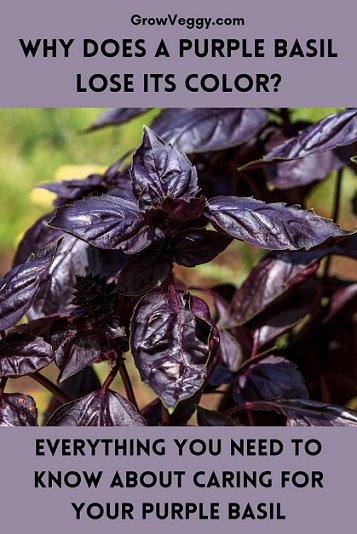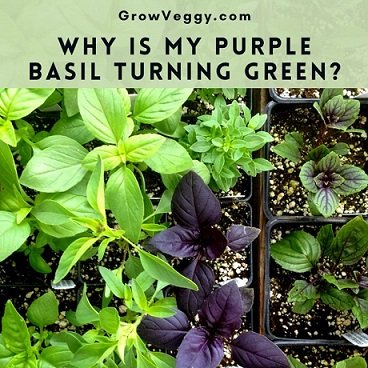Purple basil is a beautiful herb to have in the house. The intense purple color looks very rich. However, if you own a purple basil plant, you might have noticed that the deep color fades after some time, and it often turns green.
Anthocyanin is a pigment that is responsible for the purple color of basil. The lack of this pigment will change the color of the basil to green.
Why does Purple Basil turn green?
The level of anthocyanin can change (so basil leaves turn green) due to multiple reasons as below
1) Lack of light
One of the main reasons for purple basil turning to green is light.
As we know, the intense purple color in the purple basil is due to the plant pigment anthocyanin. This pigment is also responsible for red and blue colors in plants.
It is found in several varieties of basil, as well as in other fruits and vegetables like cherry, blood orange, purple cabbage, etc.
Coming from the plant itself, this pigment is produced by the purple basil in response to external factors like light.
The production of anthocyanin is directly correlated to the amount of light received. Stronger the exposure to light, the stronger the production of anthocyanin in the basil.
The more anthocyanin that is produced, the more intense will be the purple in the basil. If the pigment production is low, the purple color naturally fades and makes way for green leaves.
Green is the color of chlorophyll, which is naturally present in plants. When the pigment production reduces, chlorophyll becomes dominant, and as a result of which, the purple leaves turn green.
As long as the plant is exposed to a good amount of light, the plant will retain its deep purple color. If the quantity of light is reduced, leaves will turn green due to dominant chlorophyll.
This is why you will be able to notice changes in the plant according to seasons. Your purple basil will likely lose its color in autumn and winter, because of the lack of light during these colder months.
On the other hand, you will see the rich purple dominating the basil leaves during long light-filled summer days.
2) Genetics – Unstable Anthocyanin
According to studies, it has been found that the inheritance of the purple pigment anthocyanin can be unstable in basil.
So if you have bought purple basil seeds, there is a chance that the basil plant that grows from these seeds can have both purple and green leaves.
It might get confusing whether the problem with green leaves is genetic issues or a lack of light.
If the reasons are genetic, there will be leaves with both purple and green patches on them. If the problem is a lack of light, the purple leaves will fade from purple to green gradually.
3) Hybrid or Dual colored basil
One of the reasons why some of the leaves of your purple basil are turning green is that they might be originally green.
Anise, Licorice, Purple Bush, and Tulsi or Holy Basil are some of the Basil types that have both green and purple leaves. This color could comprise leaves, stems, or both.
All these types of basil can be described as purple basil, even while having dual colors.

Can basil be kept purple?
Although it is likely that the leaves of your purple basil may turn green, it is still possible to keep the leaves purple if you take proper care.
Of course, this solution is only if the cause of green leaves is the lack of light. In the case of genetic issues or hybrid plants, there is nothing you can do to make the leaves purple.
The solution to the lack of light is to provide more light. At least 6 hours of sunlight is required daily to keep the purple color of the basil intact.
There are a few simple ways to this
a. Change location
If you have kept the basil away from any light, maybe as a decorative piece on a table in the middle of the room, you should move the plant on a windowsill or any place where you get plenty of natural light.
If your basil is in a greenhouse, the glazing material needs to be clean to ensure good light.
b. Get a grow light
While your plant can get by with a lot of sunlight in the summers, the colder seasons will affect the amount of light provided every day.
You could be living in regions where you get sunlight for a very short time, especially in winters. In situations like this, your purple basil might still survive, but it will lose its purple color.
In this case, a grow light is your best bet. A grow light is an artificial light that works as a substitute for the missing sunlight for growing plants. With a grow light you can provide plant-quality light to your basil according to its needs.
Light is necessary if there isn’t enough sunlight because purple basil will not do well with a meager amount of light and will not produce enough anthocyanin.
HPS lamps and LED lights work well to aid basil in growing.
c. Keep your basil plant healthy
Another way that could help in keeping the plant purple is to keep the plant healthy.
The lack of anthocyanin production in purple basil can be contributed to high-stress levels. If that is the case, it is important to keep your basil healthy and stress-free.
A healthy environment with good care will lead to the healthy development of the plant. Keep the soil moist and well-drained, provide enough sunlight, get the correct container, and take good care of your basil.
That would ensure a good supply of purple basil that can be used as an ornamental piece or harvested for eating or as a garnish in various recipes.
Types of purple basil
Following are some of the common varieties of purple basil:
Dark Opal
This is one of the most famous purple basil and among the most widely used. It has a rich purple color, with pink flowers. The Dark Opal grows slower than the other basils, reaching a height of about 16 inches.
This basil is one of the most sold because it has a lot of medicinal properties as below.
- Has a warming effect, which is why these leaves can be brewed to be used in a therapeutic tea.
- Can control muscle spasms and improve nausea.
- Has antibacterial properties that can help clear up acne and soothe stings and bites from insects.
Amethyst basil
Amethyst basil is one of the darkest-toned basil, with a purple color almost black. It belongs to the Genovese category and can grow up to 20 inches.
This is different from Black spots on Basil leaves which could be due to infection from pests or disease.
Red Rubin
This variety has been created by crossing with Dark Opal. It is one of the tallest purple basils, growing to about 27 inches.
Red Rubin Purple Leaf
This variety also originates from Dark Opal. As the name suggests, red and purple colors are dominant in this plant. This basil also grows taller than the others, reaching up to 3 feet high.
Holy Sacred Red
This purple basil is a variant of the Holy Basil prominently found in India and worshipped in the Hindu religion. With mosquito-repellant properties, this basil can grow up to 20 inches.
Osmin Purple
Osmin Purple has smaller leaves than its counterparts, which are almost as rich and dark in color as the Amethyst.
Purple Ruffle
The Purple Ruffle is a cross between the Green Ruffles and the Dark Opal.
As its name suggests, this plant does indeed have ruffled leaves. The cross takes the ruffles of the green basil and the purple color of the purple basil, creating pretty purple ruffled leaves.
Purple basil Vs Green basil
Purple basil is a part of the basil family. It is one of the more common cultivars of basil that includes a variety of other basil under it.
The purple basil is generally a small plant and grows tiny flowers of different colors depending on the variety.
The leaves are ovular with a speared tip and an intense purple color. Most varieties of purple basil have a strong anise fragrance and taste like clove. It is less sweet than the common Genovese basil that is used for pesto.
Genovese basil on the other hand is vibrantly green in color.
Referred to as the common basil or the sweet basil, it can grow as tall as 24 to 30 inches. The leaves are ovular and flat.
It is the most commonly available basil in the world and the most used in recipes that call for basil. It has a rich sweet aroma and a sweet taste with just a hint of spicy flavor.
The growing conditions of green, as well as purple basil, are very similar. They require 6 to 8 hours of adequate sunlight with a well-fertilized moist soil and an ideal temperature of 21 degrees C.
The basil does not like its roots soaked in water, which is why, the soil needs to be well-drained, or else it can lead to the roots rotting away.
Purple basil may not have just purple leaves. In some cases, purple basil could comprise green leaves also if it has a pigment inheritance problem.
Purple basil in cooking
Purple basil is an ingredient for tens of thousands of recipes and is perfectly healthy and tasty to eat.
It has a strong savory flavor with a spicy taste of cloves. Hence, it won’t be used as a substitute in the exact same recipes as green basil is used.
Purple basil is also sometimes infused in vinegar to create delicious dressings for salads. The beautiful color adds good looks to the dish, and can also be used as a garnish.

